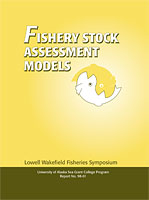
A Parametric Bootstrap of Catch-Age Compositions Using the Dirichlet Distribution
E.H. Williams and T.J. Quinn II
- Price: $0.75 Sale: $0.00
 This is part of Fishery Stock Assessment Models
This is part of Fishery Stock Assessment Models| Format | Price | |
|---|---|---|
| PDF download [583.2 KB] Bypass cart and download |
Free | Add to Cart |
Description
Stock assessment models that incorporate catch or survey age compositions and indices of abundance are commonly used for managing fisheries. Obtaining error estimates for estimated parameters in these models can be difficult. Many models incorporate a bootstrap procedure for estimating errors. In order to perform a bootstrap procedure, age compositions can be modeled by some type of statistical distribution and are often assumed to follow a multinomial process. However, the multinomial distribution is based on the assumption that a simple random sample of ages is taken from the catch, which in practice is rarely true and can lead to underestimation of error. In some applications, a smaller "effective sample size" is substituted for the actual sample size in a subjective manner. We developed an a posteriori method to model observed age compositions with the Dirichlet distribution, using the estimated age compositions from the stock assessment model. A parametric bootstrap procedure using the fitted Dirichlet distribution provided error estimates for estimated stock assessment parameters. We illustrate this technique by application to an age-structured model for Pacific herring (Clupea pallasi) from Norton Sound, Alaska. The Dirichlet procedure properly accounted for the variation in observed age compositions compared to those estimated by the stock assessment model. The effective sample sizes from the Dirichlet procedure were lower than the actual sample sizes, suggesting that a comparative multinomial bootstrap procedure underestimated the variance.
Item details
- Item number: AK-SG-98-01r
- Year: 1998
- DOI: https://doi.org/10.4027/fsam.1998.18



